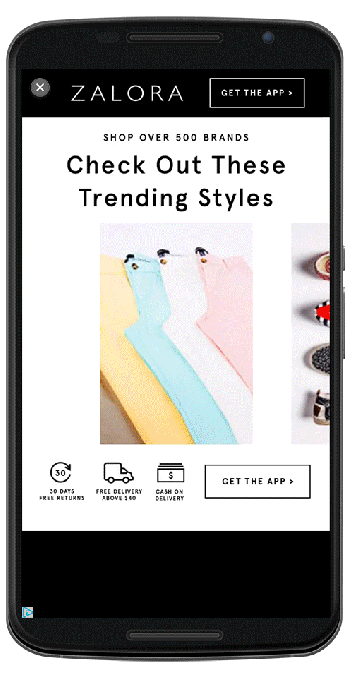Last month, Google introduced a new way for web searchers to find the information they want – even when that content was locked inside a mobile application. The search engine would return results for in-app content, and offer you the ability to “stream” the app from the web to your phone, if you didn’t already have it installed on your device.
Today, Google is expanding the capabilities of app streaming by allowing developers to take advantage of the technology for app install ads running on the AdMob network, which today reaches 650,000 applications. That means app publishers will be able to produce ads that are actually mini-versions of their mobile games themselves, up to 60 seconds in length.
The addition is one of two new app install ad formats arriving today, says Google, the other one being a way to create touchable, “swipeable,” more engaging and mobile-friendly advertisements called “Interactive Interstitials.”
The goal behind both of these formats, explains Sissie Hsiao, Google’s new head of product for mobile ads, is to help app developers find the right users.
“You can buy ads, you can get apps installed. But a lot of apps are used once or they’re never used, even after they’re installed,” she says. “We found that 1 in 4 apps is never even used, and there’s often this ‘try once’ experience, and then [the app is] never used again,” Hsiao adds.
[gallery ids="1246500,1246499,1246498"]
With the streaming app ads, the idea is to allow those who are merely interested in checking out a game or another type of app the ability to play the app – the real thing – right from within the ad itself.
These are not looping videos, or even web versions of the app. Instead, Google’s app streaming technology, which came to the company by way of an acquisition of a startup called Agawi, involves the app running on virtual machines on Google’s cloud platform. The cloud machine renders the app, executes the end users’ touch interactions, then sends the pixels back down to the client.
In other words, users will be able to play with a live, working mobile app in the mobile ad.
Called “Trial Run” ads, the format is especially interesting to mobile game developers who want to increase their likelihood of finding people who will enjoy playing their game, and, hopefully, will spend money on in-app purchases for things like virtual goods.
The “Trial Run” ads can be up to 60 seconds in length, and developers can even create custom APK files (app packages) for use with these ads. That way, users interacting with the ad won’t have to go through a sign-up flow first, or watch the introductory animation that’s included with many games – they can simply start playing.
The ads will be priced using standard app install pricing – which is per click or per conversions, if using Google’s automated system. In other words, developers may get free engagements with users who try the demo, but don’t click through to install the app.
This format has been in early alpha testing until today’s launch, but has already seen some success in terms of connecting developers with users who are more engaged, and who end up spending more in the apps, says Hsiao, but she declined to share specific metrics.
The ads are live now with a limited number of testers, including Cookie Jam (pictured above.)

Meanwhile, the new “Interactive Interstitials” ads, also debuting today, offer app developers of all sorts the ability to create custom HTML5 ads that can be interacted with using gestures like swipes, touches, and more.
For example, early tester Zalora, makers of a fashion shopping app, built an ad that allows users to swipe to discover an exclusive offer. Other app marketers could create ad formats like “scratch off’s,” or use the ads to create swipeable image carousels. They can even use live app content to create real-time ad formats, says Google.
Both new app install ad formats are available now for a limited number of testers. Interested app developers should contact their account manager if interested in joining the beta, the company says.
